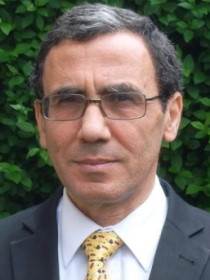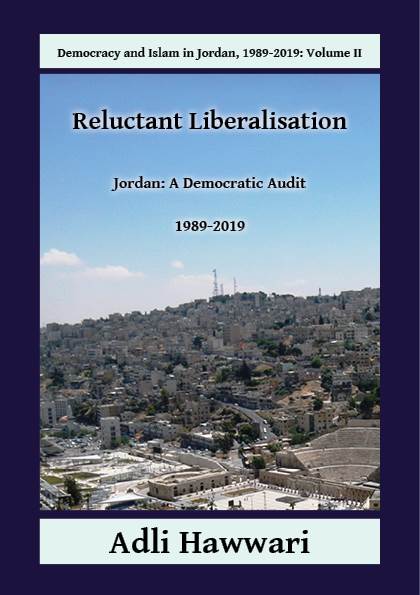Jordan: A Democratic Audit
Introduction
Dr. Adli Hawwari
 A democratic audit, as defined by Beetham (1994, p. 25), ‘is the simple but ambitious project of assessing the state of democracy in a single country’. It is accurate to suggest that it is ‘ambitious’; it is not simple. My democratic audit is based on two questionnaires: a short one for macro-analysis, and a long one for micro-analysis. I asked the respondents to give a mark out of 10, which people would find easier, as it did not impose on them a yes or no answer, or pass/fail choice.
A democratic audit, as defined by Beetham (1994, p. 25), ‘is the simple but ambitious project of assessing the state of democracy in a single country’. It is accurate to suggest that it is ‘ambitious’; it is not simple. My democratic audit is based on two questionnaires: a short one for macro-analysis, and a long one for micro-analysis. I asked the respondents to give a mark out of 10, which people would find easier, as it did not impose on them a yes or no answer, or pass/fail choice.
In addition, I interviewed twenty-three people in Jordan, including former high-ranking officials, activists, women, Muslims and Christians. In other words, I endeavoured to have a cross-section of political views.
The common overarching questions will appear in this fashion: Q1S, Q7L. This means that it is number one in the short questionnaire of fifteen questions, and number seven in the long questionnaire of ninety questions. There is little reference to theories in this book. Those interested in democratic theories, and whether democracy can be measured or not, are invited to read the detailed outlines, and critical engagement with those theories and notions in my two books: Democracy and Islam/ism and Jordan: A Democratic Audit, 1990-2010.
When the idea of a democratic audit was first entertained by Beetham, it was essential to define ‘a specification of what exactly to be audited’. Secondly, there must be ‘criteria to serve as bench marks’, according to which the audit is carried out (p. 25).
Several possible standards were rejected by Beetham: one is to assess democracy ‘against the standards of its practitioner claim to be guided by’. Another is ‘the values implicit in the political system’. A third standard is ‘what citizens themselves understand democracy to mean’ (p. 26). To adopt the first two standards would have meant acceptance that they were democratic when in fact an audit should assess how democratic they are (Beetham 1994, p. 26). The third standard was also rejected because of the ‘misuse of the term “democracy” in popular parlance has come to mean whatever political arrangements the speaker personally approves of, and has become emptied of any objective referent’ (p. 26).
Moreover, basing the standard on ‘the existing institutions and procedures of Western political systems’ has two flaws: the first is that ‘no reason can be advanced as to why we should call these institutions “democratic”, rather than “liberal”, “pluralist”, “polyarchic”, or whatever other term we choose’. Another reason is the strong possibility that adopting this standard will lead to the charge that the concept is ‘Eurocentric’ because it does not offer a way to distinguish between the ‘non-Western institutions and procedures which offered genuinely alternative ways of realizing democracy’ (p. 26).
Although Beetham should be commended for wishing to avoid Eurocentrism, I would suggest it cannot be avoided despite one’s best effort. The reason is similar to the argument about universalism. While Europe (or the West generally) is more developed, an element of Eurocentrism is inevitable.
There is agreement in the studies of democratisation that the transition from dictatorship happens through different paths and for various reasons. Every transition is influenced by local circumstances and considerations. As Geddes (2004) notes:
Many fine studies of these transitions have been written, but few of the general explanations proposed by scholars have turned out to hold across the full range of cases’ (p. 2). However, a judgment that a paradigm, concept, or modality is Eurocentric, in the sense suggested by Samir Amin (1989), must be based on criteria. Otherwise, there is a risk of comprehensively rejecting everything European or Western.
The argument against universal human rights is misguided because it can and does open the door to the abuse of rights. One would consider the merits of the anti-universal standards if the culture-specific standards were of higher benchmarks. For When the Muslim world was more tolerant of Christians and Jews, some Jews of Spain chose to live in the Muslim world. It would be possible to argue then that the Muslim human rights standards were higher than those of Spain, and therefore, it was natural to be inclined to go and live where the standards were better.
One objection to a democratic audit is that ‘the character and quality of a country’s democracy cannot be assessed by “ticking off” a set of specified criteria considered independently of one another’ (Beetham 1994, p. 31). The basis of the objection is that ‘a political system operates through a complex interrelationship between various institutions and practices’ (p. 31).
Beetham accepts the validity of the objection but argues that ‘it does not follow that we should therefore abandon generalizable criteria against which to assess the differing practices of different countries or political systems’ (p. 31).
Another objection is concerned with ‘whether it is appropriate for academics to be engaged in such explicitly evaluative and judgemental exercise’ (p. 35). Beetham (1994, p. 35) explains that not all fields of academia have problems with this involvement: ‘those who work in the field of normative political theory have less difficulty with this objection than those whose main work lies in analytical and exploratory political science’. Moreover, Beetham argues that all democratic indices are ‘necessarily evaluative and judgemental’ (p. 35).
Assigning measures on a scale is a judgemental exercise, and especially so where they become evidence to be used in the foreign policy of one country towards others. It is not unreasonable for those at the receiving end of such judgement to ask whether countries making them are prepared to be judged by similar criteria (p. 35).
After making the case for the democratic audit, Beetham lists thirty indicators of democracy. These were further developed, after collaboration with International Institute for Democracy and Electoral Assistance (IDEA), whose questionnaire stands at ninety questions.
The democratic audit has advantages over other assessments by asking questions about various elements that are considered by scholars to be part of a democratic system of government. The scholars who consider civil society to be of prime importance in democracy will be satisfied by the part in the audit which asks various questions about it. Others who attach more importance to the social and economic rights will also be satisfied. In brief, the audit takes into consideration various views of democracy.
Finally, it should be stressed that I make no claim that the six assessors, the respondents who answered the short questionnaire, and the interviewees, constitute a representative sample of Jordan’s population. This is a qualitative assessment, not a poll. I do stress, however, that the people who contributed to this assessment are diverse. Consequently, the data produced a balanced assessment.
Jordan: History and Political System
In this chapter, I provide brief backgrounds for the modern history of Jordan; its political system; the branches of government; the economy; and the Palestinian connection in Jordan’s history and politics.
History of Jordan
The modern history of Jordan is related to the downfall of the Ottoman Empire and the subsequent colonial era in which France and Britain carved out territories that were under the rule of the Ottomans. Britain and France had reached a secret agreement in 1916 (Sykes-Picot) according to which the two powers designated the areas which would come under their respective control after the end of the war. Accordingly, the region that incorporates present-day Syria and Lebanon would be under France’s control. The region from Iraq to the Mediterranean coast (including historic Palestine) was to be under British control.
The region on the eastern side of the Jordan River, Transjordan, had three separate administrative districts: ‛Ajlun, Salt, and Karak. Each had a British adviser. These three districts became the basis of an entity ruled by ‛Abdullah. This was formalised in a meeting between ‛Abdullah and Churchill in Jerusalem in March 1921. ‛Abdullah was informed that ‘he could keep Transjordan on a temporary basis under British mandatory ‘protection’ until some more permanent arrangement was agreed upon with the French’ (Salibi 1993, pp. 87-88). It was on 15 May 1923 that the ‘Emirate of Transjordan’ was recognised ‘as a national state being prepared for independence under the general supervision of the British High Commissioner in Jerusalem’ (Salibi 1993, p. 88).
Kings of Jordan
Thus far, Jordan has been ruled by four kings: ‛Abdullah I, Talal, Hussein and ‛Abdullah II. ‛Abdullah I is referred to in official Jordanian discourse as the ‘founder king’. He acquired the title of King in 1946, and ruled until he was assassinated in Jerusalem in 1951. King Talal ruled from 1951 to 1952. During his short reign, the constitution was amended to give more power to the other branches of government. When Hussein succeeded his father, Talal, he was two years under the age required. Therefore, there was a ‘council of regency’ which ruled until he reached the age of eighteen lunar years. He acceded to the throne on 2 May 1953 and ruled until his death in 1999. He is referred to in the Jordanian official discourse as the ‘father of modern Jordan’.
During Hussein’s reign, political freedoms were suppressed and political parties banned in 1957. The process of reversing that decision started in 1989. Shortly before his death, King Hussein removed his brother Hassan from the position of crown prince and replaced him with ‛Abdullah, Hussein’s eldest son. After celebrating the tenth anniversary as king, ‛Abdullah II named his eldest son, Hussein II, in July 2009 as the crown prince at the age of fifteen years.
Political System
Jordan is a constitutional monarchy. However, the king is not a figurehead, as is the case in some European countries. The Jordanian Parliament is bicameral. The lower house is the House of Deputies (HoD), and the upper is the House of Notables (HoN) (ie similar to the British House of Lords. The two chambers are known together as the National Assembly (Majlis al-Umma). The number of members of the lower house is double that of the upper. The HoN’s members are appointed by the king, while members of the lower house gain membership through elections.
After the merger of Transjordan with the West Bank in 1950, the shorthand reference to each part of the kingdom was East Bank and West Bank. Membership of both chambers was equally divided between the two parts. After the independence of Transjordan in 1946, the HoD consisted of forty members, and the HoN of twenty. The number of seats was increased in 1960 to become sixty for the lower house and thirty for the upper, with membership equally divided between the two parts of the kingdom.
The official history of Jordan’s parliament shows that the HoD was dissolved several times, because it did not work well with the government. Contrary to the normal practice in democracies, the parliament is dismissed instead of the government. In other words, the legislative branch of government is the weakest.
There are three types of courts in Jordan, according to the constitution: civil courts, religious courts, and special courts. The constitution makes references to the independence of judges who are not subjected to ‘any interference in their affairs’. In reality, however, there are episodes which undermine the independence of the justice system in Jordan, as shall be seen in another chapter.
The Economy
As ‛Aruri (1972, p. 60) noted, Jordan’s economy was weak since its creation. It suffered from ‘chronic deficit in the budget and the balance of trade’. He further noted that ‘domestic revenue has consistently lagged behind expenditure. Grants from abroad were always needed to cover expenditure, which the country was never able to meet with its own resources’.
Such a state of affairs lends Jordan to being classified as a rentier economy. The characteristic of a rentier economy, as identified by Beblawi and Luciani (1987), is ‘one where rent situations predominate’ and one which ‘relies on substantial external rents’ (p. 51; italics in original). Another characteristic is that the government is the ‘principal recipient of the external rent’ (p. 52).
As Brynen (1992) explains, Jordan’s economy and politics have the characteristics of rentierism since the state’s inception, because of the reliance initially on a British ‘monthly subsidy of £5,000’, in 1921. It then increased to ‘around £100,000 per year by the mid-1920s and to £2 million by the mid-1940s’ (p. 78).
The IMF and World Bank were involved in the endeavours to resolve Jordan’s problems through programmes agreed with both institutions. One of the government’s measures was a freeze on ‘public wages, salaries and employment and an immediate increase in the prices of petroleum products, all of which were required to meet IMF loan conditionality to curb the fiscal deficit’ (Harrigan, El-Said, and Wang 2006, p. 269).
The measures caused public discontent, manifested in disturbances in the southern cities of Ma‛an, Karak, and Tafila. Of significance is the fact that the disturbances were by the Transjordanian section of the population, whose loyalty to the regime is often presented as not being in question. The protests in the southern cities are often cited as the reason for the liberalisation.
The Palestinian Connection
Jordan’s modern history is entangled with that of Palestine. When the UN partition plan was proposed in 1947, the Palestinians and the leaders of Arab states of the time rejected it. King ‛Abdullah was in favour of acceptance. The Arab-Israeli war in 1948 forced hundreds of thousands of Palestinians to seek refuge in neighbouring Arab countries.
Two parts of Palestine remained in Arab hands; the Gaza Strip and the West Bank. There were attempts to have a Palestinian entity to carry on the fight for Palestine. The embodiment of these attempts was the Pan-Palestine Government, which came into being in September 1948. As al-Az‛ar (1998) explains, it was met with hostility by King ‛Abdullah I, and became an emasculated body, based in Cairo, until it ceased to exist in 1963. The PLO was created soon afterwards.
Al-Az‛ar documents King ‛Abdullah’s opposition to this Palestinian government, and his countermeasures to merge the West Bank with Transjordan. His attempts were fruitful, and the merger was agreed in a conference held in Jericho in December 1948.(1)
The merger with the West Bank resulted in changes in various laws to accommodate the representation of the new part of the kingdom in the government and parliament. In 1954, a law was enacted which gave Palestinians, including the refugees, the right to acquire Jordanian citizenship. Both moves (the merger and citizenship) were controversial, and created identity crises for the State of Jordan, the people of Transjordan, and the Palestinians.
When the Arab-Israeli war of 1967 broke out, three Arab states lost territories to Israel: Egypt lost the Sinai and the Gaza Strip; Syria lost the Golan Heights; and Jordan lost the West Bank. The Palestinian national movement, embodied by the PLO, sought to represent all Palestinians. In 1974, the PLO secured a resolution from the Arab summit in Rabat that declared the PLO the sole legitimate representative of the Palestinian people. The representation of the Palestinians remained an issue fraught with tension between Jordan and the PLO. Jordan was not willing to consider the PLO the representative of the Palestinians who had acquired Jordanian citizenship.
King Hussein announced in July 1988 a disengagement plan which declared that Jordan was no longer responsible legally or administratively for the West Bank. The constitutionality of this decision is debated by two opposite camps: one wants it constitutionalised so that it has a permanent effect; the other considers it unconstitutional.
The PLO reached with the Israelis in Oslo in 1993 a secret agreement, which led to the recognition of the PLO, and a form of autonomy for five years, after which the final status of the Palestinian territories occupied in 1967 would be determined. After the Israeli-Palestinian agreement was reached, Jordan wasted no time and concluded its own peace treaty in 1994.
The issue of Palestinians in Jordan is not discussed openly. For instance, the number of Palestinians in Jordan is shrouded in secrecy. Even when a census is carried out, the figure is not revealed. It should be noted that the Jordanian-Palestinian entanglement is not purely political in nature. Religious Muslims do not entertain the idea that Palestine is not their concern, whether in Jordan, Iraq, Egypt, or other Muslim countries, because Jerusalem is considered the third holiest place in the world, after Mecca and Medina. Prophet Muhammad’s journey from Mecca to Jerusalem and then ascending to the Heavens (the Night Journey) is part of the faith and is celebrated every year.
= = =
(1) I prefer the term merger to annexation because it is more precise in this instance. Mergers can be voluntary and forced. Annexations often follow a military occupation, such as Israel’s annexation of East Jerusalem and the Golan Heights.
Adli Hawwari (2020). Reluctant Liberalisation: A Democratic Audit of Jordan, 1989-2019. London: Ud Al -Nad Ltd.

- Jordan: A Democratic Audit
 https://orcid.org/0000-0003-4420-3590
https://orcid.org/0000-0003-4420-3590




